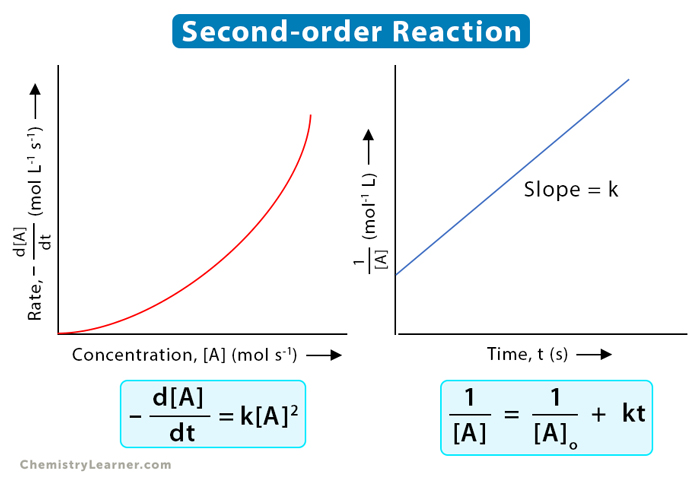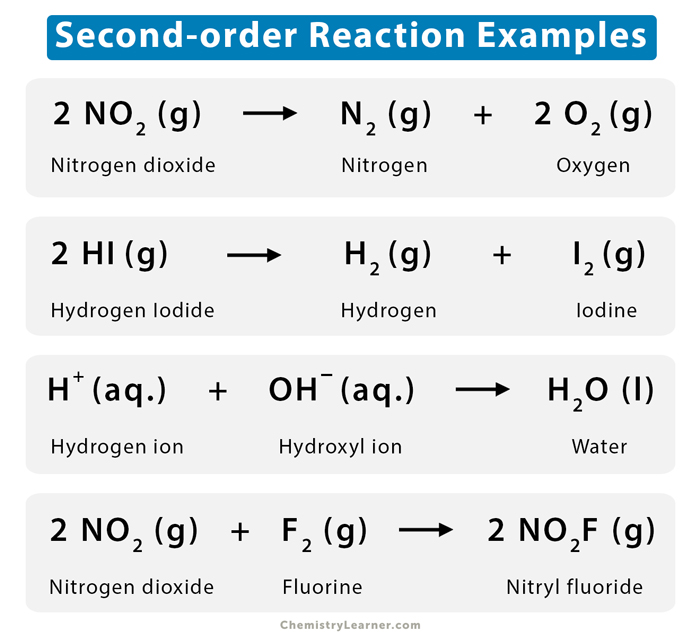Second Order Reaction
A second-order reaction is one whose rate depends on the square of the concentration of one reactant or the product of the concentrations of two reactants. In other words, the reaction rate depends on the concentrations of one second-order reactant or two first-order reactants [1-4].
Equations
The second-order reaction can be generally represented in two ways [1-5].
Type 1: Two molecules of one reactant react to form a product.
2A → Product
The reaction rate is given by
Rate ∝ [A]2
=> R = k [A]2
Where [A] is the concentration and k is the rate constant.
This type of reaction is common in dimerization, where two monomers combine to form a polymer. Note that if the concentration is doubled, the rate is quadrupled. If the concentration is reduced by one-half, the rate is reduced by one-fourth.
Type 2: One molecule each of two reactants [A] and [B] reacts to give products.
A + B → Products
The rate is given by
Rate ∝ [A][B]
=> R = k [A][B]
Units
The unit for the reaction rate is moles per liter per second or mol L-1 s-1, and the concentration unit is moles per liter or mol L-1. Solving for the unit of the rate constant k gives
mol L-1 s-1 ≡ k (mol L-1)2
=> k ≡ mol -1 L s-1
Therefore, the unit for the rate constant is mol-1 · L · s-1.
Differential Rate Law
Since the reaction rate is the negative time derivative of concentration, the differential form of the rate law can be written as follows.
– d[A]/dt = k[A]2
Integrated Rate Law
Rearranging and integrating the above equation gives the integrated rate law.
=>-∫d[A]/[A]2 = k∫dt
=> 1/[A] = kt + C
Where C is a constant. Suppose, at t = 0, [A] = [A]o. The equation becomes
1/[A]o = C
Therefore,
1/[A] = kt + 1/[A]o
Graphs
The above equation is the integrated rate law with the form y = mx +c. The term 1/[A] varies linearly with time. So, a plot of 1/[A] vs. t will yield a straight line with slope k and intercept 1/[A]o, as shown below [1-5].
Half-life
The half-life of a chemical reaction is the time taken by the reaction to consume half the reactant. At half-life, the reactant’s concentration is reduced by 50% or [A] = [A]o/2. Suppose t1/2 is the half-life. Then, the above equation gives [1-5]
2/[A]o = 1/[A]o + kt1/2
=> t1/2 = 1/(2k[A]o)
Examples [1-5]
Type 1
1. Nitrogen dioxide (NO2) decomposes into nitrogen (N2) and oxygen (O2).
2 NO2 (g) → 2 NO (g) and O2 (g)
2. Hydrogen iodide (HI) breaks down into hydrogen (H2) and oxygen (O2).
2HI (g) → H2 (g) + I2 (g)
Type 2
1. Hydrogen ion (H+) and hydroxyl ion (OH–) combine to form water (H2O).
H+ (aq.) + OH– (aq.) → H2O (l)
2. Nitrogen dioxide (NO2) and fluorine (F2) combine to produce nitryl fluoride (NO2F).
2 NO2 (g) + F2 (g) → 2 NO2F
The dimerization of the monomer 2,5-dimethyl-3,4-diphenylcyclopentadienone to produce a dimer is a second-order reaction. This reaction is significant in the pharmaceutical industry to prepare complex drugs.

